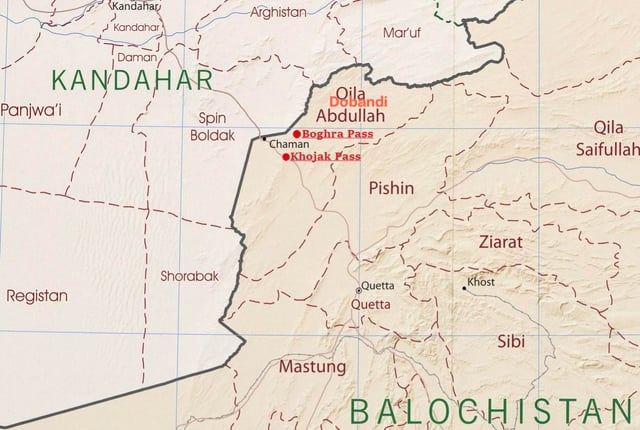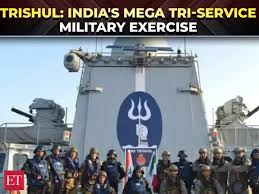1. Overview
Exercise Name: Tri-Services Exercise “Trishul” (TSE-2025)
Led by: Indian Navy
Participating Services: Indian Army, Indian Air Force, and Indian Navy
Timeframe: Scheduled for early November 2025
Purpose: To enhance joint operational readiness, interoperability, and synergy among the three Services.
2. Scope and Strategic Significance
Coordinating Headquarters: Western Naval Command (Mumbai)
Geographical Coverage:
Creek and Desert Sectors – Rajasthan and Gujarat
Maritime Zones – North Arabian Sea
Strategic Aim:
Strengthen jointness and integration across land, air, and sea operations.
Reinforce India’s ability to conduct multi-domain warfare and large-scale integrated operations.
Significance:
Marks one of India’s largest integrated military drills.
Reflects India’s growing focus on joint theatre commands and comprehensive national defence preparedness.
3. Participating Formations and Agencies
Indian Army: Southern Command
Indian Navy: Western Command
Indian Air Force: South Western Command
Supporting Agencies:
Indian Coast Guard
Border Security Force (BSF)
Other Central and Civil Defence Agencies
Importance:
Promotes inter-agency coordination between the armed forces and civil security agencies.
Ensures whole-of-government preparedness for hybrid and cross-domain threats.
4. Operational Objectives
Main Goals:
Validate joint operational procedures across the three services.
Improve interoperability of platforms and communication networks.
Refine joint tactics for land-air-sea coordination.
Key Operational Areas:
Amphibious Operations: Coordinated beach landing and sea-to-land assault missions.
Carrier-Based Operations: Use of aircraft carriers for integrated air-sea missions.
Effect-Based Operations: Combining precision strikes with real-time intelligence.
Technological and Tactical Components:
ISR (Intelligence, Surveillance, Reconnaissance): Integrated monitoring across all domains.
EW (Electronic Warfare): Testing countermeasures and jamming capabilities.
Cyber Warfare: Strengthening cyber defence and network resilience.
5. Key Assets and Equipment
Naval Assets:
INS Jalashwa (amphibious assault ship)
Landing Craft Utility (LCUs)
Air Force Assets:
IAF Fighter Aircraft and transport platforms
Army Assets:
Mechanised and armoured units for desert warfare
Indigenous Systems:
Reflects the Aatmanirbhar Bharat vision through use of indigenously developed platforms, sensors, and communication systems.
6. Integration and Future Readiness
Joint Carrier and Shore-Based Operations:
Seamless integration of Navy and Air Force assets.
Practice of coordinated missions involving ships, aircraft, and ground forces.
Technology-Driven Warfare:
Focus on AI-enabled decision support, network-centric warfare, and data fusion.
Future Orientation:
Aligns with India’s goal of establishing theatre commands for integrated defence management.
Enhances combat readiness for emerging threats like drone warfare, hybrid warfare, and cyber attacks.
7. Strategic Importance for India
National Security: Strengthens India’s defence posture along the western coast and borders.
Regional Stability: Demonstrates India’s capacity to secure its maritime and territorial interests.
Diplomatic Message: Projects India’s preparedness and deterrence capability amid evolving regional dynamics in the Arabian Sea and Indian Ocean Region (IOR).
8. UPSC Exam-Oriented Facts
| Aspect | Details |
|---|---|
| Name | Tri-Services Exercise “Trishul” 2025 |
| Lead Service | Indian Navy |
| Other Participants | Indian Army & Indian Air Force |
| Key Commands Involved | Western Naval Command, Southern Command, South Western Command |
| Area Covered | Rajasthan, Gujarat, North Arabian Sea |
| Key Assets | INS Jalashwa, LCUs, IAF fighter aircraft |
| Focus Areas | Amphibious ops, Carrier ops, ISR, EW, Cyber Warfare |
| Theme | Jointness, Interoperability, Technology-driven readiness |
| Aatmanirbhar Bharat Link | Use of indigenous defence platforms and systems |
9. Summary
Exercise “Trishul” 2025 is a landmark step in India’s journey toward joint theatre warfare capability.
It integrates the Army, Navy, and Air Force in multi-domain operations, promotes inter-agency coordination, and strengthens India’s strategic preparedness in an era of evolving hybrid threats.







